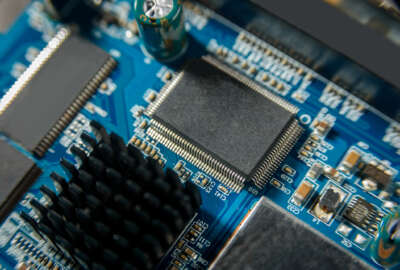
David Schild, Executive Director of the Printed Circuit Board Association of America
Semiconductor chips have gotten all of the attention and a $50 billion subsidy from the government. But without the more prosaic Printed Circuit Boards (PCBs)...
Semiconductor chips have gotten all of the attention and a $50 billion subsidy from the government. But without the more prosaic Printed Circuit Boards (PCBs) underneath them, chips don’t do anything. PCB manufacturing has mostly moved offshore, leading to a pending bill to help the industry, as the nation focuses on the supply chain. For more, the Federal Drive with Tom Temin spoke in-studio with David Schild, the Executive Director of the Printed Circuit Board Association of America.
Interview transcript:
Tom Temin Give us the statistics. PCBs were started here and they used to be just a piece of cardboard with holes in it. And you’d stick the transistor in and solder the back side. It’s a pretty high tech thing now, Printed Circuit Boards. How much is still here? And how much has gone overseas?
David Schild Well, you’re absolutely right that a Printed Circuit Board is an example of high technology, and it’s part of a microelectronics ecosystem that makes really every aspect of modern life possible. From F-35s to F-150s. We’ve got to have semiconductors, but those semiconductors have got to sit on Printed Circuit Boards to make pretty much all of modern life function for us. And you’re right, we’ve had a significant contraction in the size of American industry. 25 years ago, we had 30% of market share. 30% of PCBs were produced here in America. In real terms, that was 2200 companies. Today, less than 4% of PCBs are made in America by less than 150 companies. So there’s been a very significant contraction and real offshoring of a critical technology.
Tom Temin And for the semiconductors to be useful, as you say, they have to be attached to the board. And that all involves very sophisticated waves, soldering machinery, pick and place, numerically controlled. It’s pretty amazing to watch. Does the population of the boards, does that also take place mostly overseas? Or can boards be shipped back here? And we still do the assembly and soldering and all of that here?
David Schild I think that you’re talking about a global ecosystem that’s going to remain multi-content, multi-country. What we see is a real imbalance in the supply chain, a real dependency on one region of the world. And as we saw during the pandemic, when we extend supply chains overseas and we have to rely on foreign sourcing, sometimes we can have empty store shelves, we can have empty car dealership parking lots. That’s not what we want. I think the imbalance, the contraction of this industry, it’s not healthy for the economy. And certainly as the [Creating Helpful Incentives to Produce Semiconductors (CHIPS)] Act makes an investment in American semiconductors, we should be making those up with American substrates. We should be making those up with American PCBs right here, and not have all this technology going back and forth across the ocean.
Tom Temin And the semiconductor industry is very well-organized. It’s got several national associations that have had a lot of policy impact for many, many years. I used to go to the annual Semiconductor Industry Association dinner and get chicken fried steak there with Jerry Sanders. What about PCBs? Are they less organized? Is that more of a mom and pop type of business?
David Schild Well, two years ago, a number of industry executives realized that we needed an investment by the federal government and we needed a voice in Washington. And thus, the Printed Circuit Board Association of America or PCBAA, was formed. We’ve grown to over 27 members today, and certainly we need to get bigger and speak with a louder voice in Washington. But I think that we’re really the lead sled dog when it comes to advocating, for this part, of the microelectronics ecosystem. And of course, we’re partnered with organizations like [Institute for Interconnecting and Packaging Electronic Circuits (IPC)] and [U.S. Partnership for Assured Electronics (USPAE)] on this effort. And I think our friends, in the semiconductor space, understand that this is a partnership. And as they grow, we need to grow as well.
Tom Temin And the nature of the PCB industry that is still in the United States, is it the multilayer, really complex type of finely manufactured board or is it just the, well, there’s lower levels that you would might put in a toaster, as opposed to an F-35.
David Schild I think you’d find varying levels of complexity. But of course, products that end up in national defense applications have to be made right here in America. The Defense Department requires it, our members are proud to do it. And so, certainly for a lot of aerospace and defense applications, right here in America we’re making state of the art printed circuit boards.
Tom Temin All right. We’re speaking with communications consultant David Schild, who is representing the Printed Circuit Board industry. And you’re also running there association, too, aren’t you?
David Schild That’s exactly right. I’m fortunate enough to be the executive director of PCBA, and excited for what we’ve got lined ahead in Washington.
Tom Temin Well, association heads have special challenges, but this is the world capital for it, so you’re in the right place. And why did the circuit board industry leave the United States? There’s an environmental impact that they have and that can get expensive and complicated, and the labor costs or what else?
David Schild I think that if you look at what’s happened over the last 25 years, we as a nation have not prioritized American manufacturing, and specifically, high tech manufacturing. And other nations have. And foreign subsidies make it very attractive to do business, in other nations, to build factories to hire workers. But there’s no reason that can’t be done here. As we’ve seen with the CHIPS Act, where public money goes, private money will follow. That $52 billion that you mentioned, that the CHIPS Act brings to the table, it’s been matched by $400 billion from private industry. We believe that a similar investment in PCBs, and we’re asking for a fraction of that money, 3 to $5 billion for capital expenditures for workforce development. We believe that will be matched by private investment. And I think the more important part of our initiative is a tax credit. An incentive for the manufacturers to buy American PCBs, let’s make it attractive to buy high technology built here in America. And we think then, the whole ecosystem grows and thrives domestically.
Tom Temin And there was a bill in the 117th Congress to do that, not reintroduced in the 118th. Who’s behind it? And what are what else do we need to know about that bill?
David Schild Well, we’re proud that we have bipartisan support for what was known as the supporting American Printed Circuit Boards Act. I’m confident that’s going to be reintroduced soon. And again, we’ve got champions on both the left and the right, the R’s and the D’s. Because I think, it’s a nonpartisan issue to say that we want to have more high technology manufactured here in America. And I think that the Congress, on the heels of the success of the CHIPS Act, should take up the rest of the ecosystem and move forward with this bill and others.
Tom Temin They’ve got a lot of priorities. Who are the principal sponsors?
David Schild Sure. We’re very lucky to have Representative Blake Moore (R-Utah) and Representative Anna Eshoo (D-Calif.), as the original co-sponsors of this legislation. And we’ve met with a lot of folks on the Hill, and we see a lot of interest and a lot of champions for American high tech manufacturing.
Tom Temin And you mentioned that, of course, for military use, a PCB and the rest of it has to be manufactured in this country. So do you get the sense that [Department of Defense (DoD)] is invested in this particular issue, or do they feel like they’re okay supply chain wise?
David Schild Absolutely. The Department of Defense, I think, is one of the original federal agencies that realized that we have challenges around microelectronics sourcing. And for many years, they have been invested in shoring up domestic capacity and making sure that their supply chains, for the things that our men and women depend on to do their jobs and come home safely, that those things are reliable, that they’re trusted, and that they’re ready when the men and women in uniform need them. So the DoD has been all over this issue. They’ve got a number of officials who are focused on this. And honestly, they’ve been great partners with our industry in helping to amplify our message.
Tom Temin So right now, the main thrust of the association is to get Congress to reconsider this bill.
David Schild Absolutely. We think that the president’s message from last week, let’s finish the job, applies very well to a discussion about microelectronics manufacturing. We’ve made investment in semiconductors, but chips don’t float. We can’t go anywhere if we’re simply making semiconductors here in America. Let’s finish the job, let’s invest in PCBs and substrates.
Copyright © 2025 Federal News Network. All rights reserved. This website is not intended for users located within the European Economic Area.
Tom Temin is host of the Federal Drive and has been providing insight on federal technology and management issues for more than 30 years.
Follow @tteminWFED





